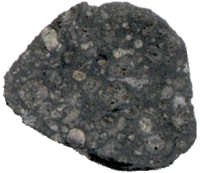
August Editorial
Do we owe our existence to meteorites?

August Editorial
Do we owe our existence to meteorites?
|
Meteorites are natural objects from outer space which survive the impact with our atmosphere. (Technically those which burn up as ‘shooting stars’ should be called meteriods.) Meteorites can be really small or very large. In the past some large meteorites have hit the earth’s surface with enough force to leave substantial craters for later geologists to study. Take, for example, the Vredefort Dome in South Africa. This is a crater resulting from the strike of a meteorite estimated at 10 km in diameter. A meteorite this size would have vaporised about 70 cubic km of rock to create the crater which is 300 km in diameter. Fortunately for those now living in the region, the impact happened about 2 billion years ago. In fact the Vredefort Dome is the oldest and the largest and most clearly-visible meteorite impact site in the world.
|
Meteorites which enter the Earth’s atmosphere at a velocity capable of causing a substantial surface impact are usually iron meteorites. But the good news for those living at ground zero is that iron meteorites make up only about 6% of all meteorites which fall on Earth. Most of the other meteorites are so-called ‘stony meteorites’. Stony meteorites, even large ones, do not survive intact after hitting the atmosphere and normally disintegrate into small pieces. As a result of the break-up even those stony meteorites which make it to the ground are seldom moving fast enough to leave a crater. | |
|
By far the most common meteorites which fall to Earth are stony meteorites called chondrites. The chondrites particularly interesting some scientists right now are in a group called carbonaceous chondrites. Carbonaceous chondrites are 'organic-rich' meteorites. This has made them the focus of much research ever since nucleobases were found in these meteorites some 50 years ago. Nucleobases are a group of nitrogen-based molecules essential for the construction of RNA and DNA. So, if the implications of this discovery are bourne out, it seems that the the building blocks of life on Earth might have originated in outer space and piggybacked down to Earth on meteorites. However, the scientists who made these early discoveries had to struggle with the question of whether the nucleobases which they found in the chondrites were indeed extraterrestrial and not merely contamination by terrestrial nucleobases once the meteorites had arrived on earth. All the nucleobases in the meteorites were structurally identical to their terrestrial equivalents. No structurally different analogue neucleobases were ever found. And this created controversy because one would expect that extraterrestrial material would contain considerable structural diversity. Now recent research funded by NASA - published this month in the Proceedings of the National Academy of Sciences - shows new evidence that Earth's DNA building blocks may in fact have originated in outer space. The researchers analysed samples from 12 carbonaceous chondrites, including samples from nine meteorites found in Antarctica. Ten of these meteorites were tested to see if they contained neucleobases. Two of these meteorites were found to have an array of nucleobases and compounds that are structurally similar (so-called nucleobase analogs). They had adenine and guanine - two of four neucleobases that make up DNA ( the full set being cytosine, guanine, adenine and thymine). But the meteorites had also also three unusual neucleobase analogs which are very rare in terrestrial biology and were not present in any of the control samples. The control samples were taken from (for example) procedural blanks, terrestrial soil, and Antarctic ice. The researchers concluded that the necleobase analogs seemed to be unique to these meteorites. The group went further, and attempted to re-create the nucleobases and analogs in the laboratory using reactions of ammonia and cyanide (both chemicals being common in space). Their synthetic nucleobases were similar to those in the meteorites, although their relative proportions were different. Nevertheless, the fact that the neucleobases can be produced with chemical compounds commonly found in outer space shows that prebiotic material can be manufactured in extraterrestrial bodies - for example, in asteroids. James Cleaves, a participant in the study, has commented : "This shows us that meteorites may have been molecular tool kits, which provided the essential building blocks for life on Earth." Journal Reference: Michael P. Callahan, Karen E. Smith, H. James Cleaves II, Josef Ruzicka, Jennifer C. Stern, Daniel P. Glavin, Christopher H. House, and Jason P. Dworkin. Carbonaceous meteorites contain a wide range of extraterrestrial nucleobases. (2011) PNAS 108 (34), 13995-13998. | |
| _______________________________ | ||||
| Home | | | Shopping | | | Database |
© Biscuit Software 2004-2015
All rights reserved